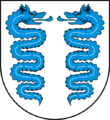Lugano District facts for kids
Quick facts for kids
Lugano District
Distretto di Lugano
|
|
|---|---|
|
District
|
|
| Country | |
| Canton | |
| Capital | Lugano |
| Area | |
| • Total | 331.8 km2 (128.1 sq mi) |
| Population
(2020)
|
|
| • Total | 150,556 |
| • Density | 453.76/km2 (1,175.22/sq mi) |
| Time zone | UTC+1 (CET) |
| • Summer (DST) | UTC+2 (CEST) |
| Municipalities | 47 |
The Lugano District (also known as Distretto di Lugano or Luganese) is a part of Canton of Ticino in southern Switzerland. Think of it like a county or a region within a larger state. The main city and capital of this district is Lugano.
As of 31 December 2020, about 150,556 people live in the Lugano District.
Contents
Geography
The Lugano District covers an area of about 301.76 square kilometers. That's roughly the size of 42,000 football fields!
A big part of this land, about 66.5%, is covered by forests. Imagine lots of trees and green spaces! About 15.7% of the land is used for farming, where crops are grown and animals graze. Another 15.3% is developed with buildings and roads, where people live and travel. A small part, less than 1%, is made up of rivers and lakes.
Demographics
The Lugano District is home to many people. As of December 2020, the population is about 150,556 people.
Most people in the district speak Italian. About 104,413 people speak Italian. Other languages spoken include German (by about 11,397 people) and French (by about 2,683 people). A small number of people also speak Romansh.
In 2008, there were slightly more females than males living in the district. About 52.2% of the population were female, and 47.8% were male.
The population is growing! In 2008, more babies were born than people died. Also, more people moved into the district than moved out. This means the population increased by about 1.7% in that year.
The age groups in the Lugano District in 2009 were:
- About 9.2% of the population were children aged 0 to 9 years old.
- About 10.1% were teenagers aged 10 to 19.
- Adults aged 20 to 59 made up about 55.1% of the population.
- People aged 60 and older made up about 25.7% of the population.
Most homes in the district are single-family homes or multi-family buildings. In 2000, there were over 103,000 buildings where people lived. Most apartments had three rooms, and about 78% of all apartments were lived in all year round.
The population of the Lugano District has grown a lot over the years:
| year | population |
|---|---|
| 1850 | 36,494 |
| 1880 | 39,447 |
| 1900 | 45,031 |
| 1950 | 63,110 |
| 1980 | 104,559 |
| 1990 | 115,116 |
| 2000 | 128,581 |
Politics
In Switzerland, people vote for their leaders and parties. In the 2007 federal election, the most popular political party in the Lugano District was the FDP. They received about 26.24% of all the votes. Other popular parties included the CVP and the SP.
About 46.5% of eligible voters participated in this election. This means almost half of the people who could vote, did vote.
Religion
In 2000, most people in the Lugano District were Roman Catholic, making up about 73.4% of the population. About 7.7% belonged to the Swiss Reformed Church. Some people belonged to other churches, and a small number did not state their religion.
Education
The Lugano District has a good education system. In 2009, there were over 22,000 students in the district.
Children can start with non-mandatory kindergarten for up to three years. After that, they go to primary school for five years. Primary school includes both regular classes and special schools for students who need extra support.
After primary school, students move to lower secondary school. Here, they have a few choices:
- They can attend a two-year middle school, followed by a two-year program to prepare for a job (pre-apprenticeship).
- They can join a four-year program that gets them ready for higher education, like university.
For upper secondary school, students prepare for a trade or for university. Some students learn a trade while also doing an internship or apprenticeship. This can take three or four years. Others go to school full-time for a year or part-time for one and a half to two years, then do an internship.
There are also professional programs that last three years. These programs train students for jobs in fields like engineering, nursing, computer science, business, and tourism.
Circles and Municipalities
The Lugano District is divided into 12 smaller areas called "circles." Within these circles, there are 59 different towns and villages, which are called municipalities. Each municipality has its own local government and community.
For example, the city of Lugano itself is so big that it's divided into two circles: Lugano Ovest (West Lugano) and Lugano Est (East Lugano).
Other circles include:
- The Circle of the Ceresio, which has municipalities like Val Mara and Brusino Arsizio.
- The Circle of Carona, with towns such as Paradiso and Melide.
- The Circle of Magliasina, including Caslano and Tresa.
- The Circle of Agno, with municipalities like Agno and Bioggio.
- The Circle of Sessa, which includes Astano and Bedigliora.
- The Circle of Vezia, home to towns like Vezia and Cureglia.
- The Circle of Breno, with municipalities such as Alto Malcantone and Novaggio.
- The Circle of Capriasca, which includes Capriasca and Ponte Capriasca.
- The Circle of Taverne, with towns like Torricella-Taverne and Monteceneri.
Merger and Name Changes
Over time, some smaller municipalities in the Lugano District have joined together to form larger ones. This helps them work more efficiently and share resources.
Here are some recent changes:
- On April 14, 2013, several municipalities like Bogno, Cadro, and Carona became part of the city of Lugano.
- On April 18, 2021, the municipalities of Croglio, Monteggio, Ponte Tresa, and Sessa merged to create a new municipality called Tresa.
- On April 10, 2022, Maroggia, Melano, and Rovio joined together to form the new municipality of Val Mara.
Images for kids
See also
 In Spanish: Distrito de Lugano para niños
In Spanish: Distrito de Lugano para niños
















































